Meet the 2025 Toshiba/NSTA ExploraVision Regional Winners
The Toshiba/NSTA ExploraVision Competition aims to inspire K-12 students across the United States and Canada to put their problem-solving thinking skills to the test during this science challenge. Students are tasked to use their critical thinking, leadership, and collaboration skills that are central to the Next Generation Science Standards.
Toshiba and the NSTA recently announced the regional winners of the 33rd annual ExploraVision competition. This year’s regional winners’ projects include innovative ideas ranging from specialized glasses that convert sign language into speech to a portable device to help people with nut allergies detect nuts in the food they eat.
The 24 winning teams will advance to the national phase of the competition, where participants will have a chance to win $10,000 U.S. Series EE Savings Bonds (at maturity) and other prizes. The winning teams will also receive Chromebooks to support the creation of virtual posters, team websites, and short videos showcasing the team’s technology for the national phase of the competition.
Keep reading to learn more about this year’s regional winners and their projects.
2025 ExploraVision Regional Winning Teams
Mist Tower and Climate Checker
Created by 3rd graders Mason Duchesne, Isaiah Kiger, and Zoe Frost from Cascade Brook School in Farmington, Maine. Supported by Coach Sandra Jamison.
The Mist Tower and Climate Checker is a drought relief technology that helps regulate temperatures in order to boost bamboo growth. The idea is that the Mist Tower will shoot mist across the area where bamboo grows to keep it cool and hydrated. The Climate Checker then finds where high temperatures are and transmits this information to send the mist tower. The ultimate goal is to help the pandas have more bamboo to eat to continue to preserve their population.
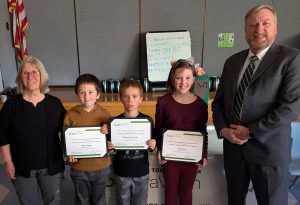
The Drone Cleaner
Created by 3rd graders Riley Bahr, Juliet Stinnett, Ainsley Capps, and Annabelle Anderson from Blessed Sacrament Huguenot School in Powhatan, Virginia. Supported by Coach Ashley Mertz.
The Drone Cleaner is a drone that will fly around and pick up trash, separates the trash and then either disposes of it or recycle it. The goal is to help reduce waste and litter.
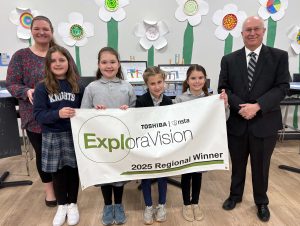
Eye Understand: Glasses for People Who Use Sign Language
Created by 2nd graders Jael Zeeb, Erandi Horn-Gomez, Mia Rodriguez, and Rebecca Brandt from A.D. Henderson University School in Boca Raton, Florida. Supported by Coach Jennifer O’Sullivan.
Only 2.8% of people in the U.S. know sign language, making communication difficult for many deaf individuals. This team developed smart glasses that translate sign language into speech. The built-in camera records hand gestures, sends the video to an app for translation, and the glasses speak the words aloud. The goal of this innovative solution is to make communication more accessible for all.
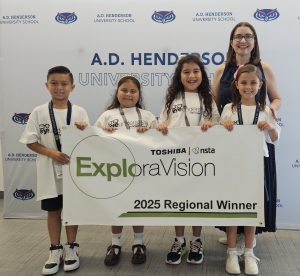
Breathe Buddy
Created by 4th graders Diane Abzalov, Saira Sahai, and Juno Granit-Welch from A.D. Henderson University School Boca Raton, Florida. Supported by Jennifer O’Sullivan
Breathe Buddy is a wearable watch designed to help people with asthma. It monitors heart rate, oxygen levels, and breathing patterns, alerting users early if an asthma attack is coming. The watch can deliver a small dose of medication through the skin if needed and notifies caregivers for extra help. This device aims to make asthma management easier, ensuring medication is always available, reducing the risk of missed doses, and offering peace of mind to users and their families.
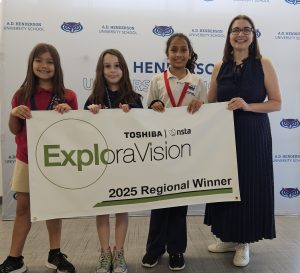
BlazeBlock: The Hemp Revolution That Stops Fires Cold
Created by 3rd graders Sofia Taha, Kason Sonnenberg-Trent, and Charlie Pilgrim, from Don Campbell Elementary School in Alberta, Canada. Supported by Coach Melinda Powell and Mentor Rabia Taha.
BlazeBlock is a building material designed to protect homes from fires by actively suppressing flames. With the eco-friendly benefits of HempBlock, BlazeBlock integrates fire-activated microcapsules, smart thermal sensors, and bio-engineered mycelium to detect and combat fires in real-time. The microcapsules release fire-retardant gel when exposed to heat, while the sensors trigger an alert to fire response systems. Additionally, the mycelium network releases natural fire-retardant compounds, providing a self-extinguishing feature. BlazeBlock is set to redefine fire safety in homes, combining sustainability with innovative fire-fighting capabilities.
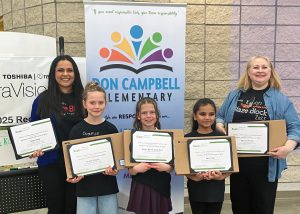
Raynaud’s Ring
Created by 3rd graders Addison Boyer, Breyer Cheeks, Ezekiel Perez and Mason Beverage from John Ross Elementary School in Edmond, Oklahoma. Supported by Coach Heidi Walter
There is a condition called Raynaud’s Syndrome that makes hands, fingers and toes react to cold temperatures by turning white and becoming painful. The team created a ring that could be worn, and it would help solve this problem for all users with Raynaud’s Syndrome.
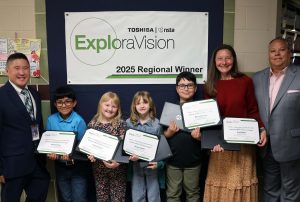
The AniSensor
Created by 2nd graders Ayira Varre and Yuelin Li from STEM School Highlands Ranch in Colorado. Supported by Coach Tami Brook and Mentor Kirti Priyanka Vanapalli.
Living in Colorado, this team often sees wildlife crossing major roadways, sometimes even becoming injured. To keep both wildlife and the community safe their AniSensor device uses infrasound sensors, cameras, and thermal imaging to detect animals on roads. Mounted like a dashcam, it alerts drivers early, allowing them to avoid collisions. This innovation aims to protect wildlife and humans, reduce material damage, and make roads safer for everyone.
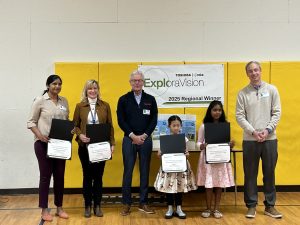
Biomimetic Surfaces
Created by 7th graders Anirudh Rao and Aarna Varre from STEM School Highlands Ranch in Colorado. Supported by Coach Sheetal Rajput and Mentor Bharathi Rao.
The goal of the Biomimetic Surfaces is to address the problem of icy roads by introducing a novel approach based on the properties perfected by nature over millions of years of evolution. Using biomimicry and hydrophobic properties of flora/fauna, this team found a unique way to improve the design of road surfaces to reduce icy conditions, increase friction, and improve vehicle stability. This design can be stamped into concrete or used in materials pre-formed with the pattern, making it ideal for roads and other surfaces where ice formation is undesirable. The solution can be customized for various applications to prevent ice buildup.
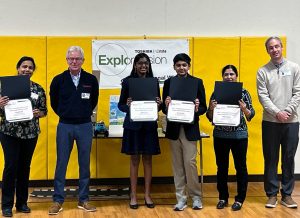
Visionary
Created by 6th graders Edward Grossman, Cole O’Connor, Sam O’Donoghue, and Sullivan Limmer from Long Beach Middle School in Lido Beach, New York. Supported by Coach Walter Kramme.
Visionary is an artificial eye that mimics real eye function using AI and a microchip as a connection point. It aims to integrate artificial components like the retina, pupil, and lens, building on past prototypes, with advancements in AI and microchip technology needed to make it a reality.
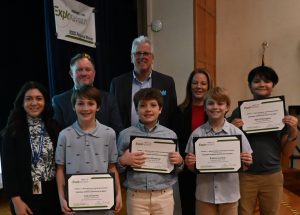
Electro-Buzz
Created by 4th graders Luciana Nishanian and Scarlett Lin from Willow Springs Elementary School in Fairfax, Virginia. Supported by Coach Logan Williams and Mentor Nunik Nishanian.
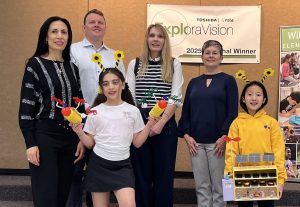
Focus Pro
Created by 5th graders Anisha Neklikar, Diptam Chakrabarty, and Shreyan Khan from Hoover Math and Science Academy in Schaumburg, Illinois. Supported by Coach George Schaupp and Mentor Kalpana Godse.
The kid-friendly ADHD Buddy watch is designed to help significantly improve time management and focus while addressing behavioral challenges. Given the complexity of ADHD, predicting episodes of their agitation using wireless EEG and Brain-Computer Interface, supported by AI will help caregivers immensely. Multiple key features including parental monitoring along with proprietary FoodTrak technology to identify safe foods best suited for the ADHD kid by comparing against USDA database in the absence of parents make this watch a “true friend in need.” ADHD Buddy watch encourages independence for kids and empowerment for parents and promises to potentially improve children’s ability to focus, stay organized, and manage their time—all while fostering greater emotional regulation and self-awareness.
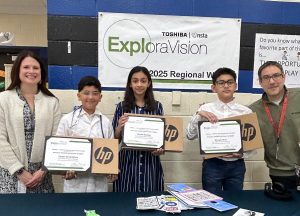
SeaSpark
Created by 6th graders Yuvaanh Agarwal and Nirvaan Benny from The Village School in Houston, Texas. Supported by Coach Laura Jowers.
The SeaSpark system addresses global issues of electricity and clean water access. It generates hydroelectricity using turbines and purifies water through carbon filters, titanium dioxide, and sunlight. This self-sustaining, eco-friendly process produces potable water in 40-50 minutes, with minimal waste and environmental impact.
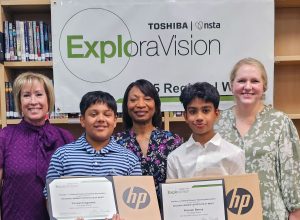
Lost Then Found
Created by Gustavo Lopez (4th grade), Uriah Molly (4th grade), Teddy Thomas (2nd grade), and Mari Truong (2nd grade) from Heritage School in Salem, Oregon. Supported by Coach Maureen Foelkl.
Dementia is a serious illness that impairs a person’s ability to think and remember. Lost Then Found is an innovative micro-patch worn between the shoulder blades, tracking the user’s location in real-time using quantum technology. A quantum accelerometer measures movement, while body heat powers the patch. It securely attaches with micro-suckers, and caregivers use a sharing app to monitor the wearer’s location. Lost Then Found offers peace of mind by quickly locating loved ones who are battling dementia.
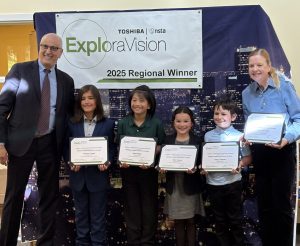
Smart Tape
Created by 9th graders Gabriella Ravosa, Jonathan Kakule, and Luna Wai Tung Li from Wilbraham & Monson Academy in Wilbraham, Massachusetts. Supported by Coach Matthew Rafala.
Anterior cruciate ligament tears are an injury which propels athletes to abandon sports or perform at a lower level than before. Instead of wearing thick and uncomfortable braces for a long time, Smart Tape aims to make the post-surgery recovery process easier and faster. This product contains all that is needed for ACL recoveries, from strong support to painkillers and bone growth proteins. This tape benefits users in the field and going through rehabilitation.
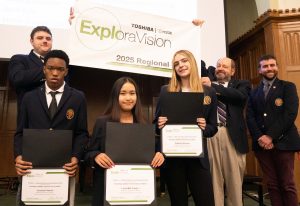
Breathe Easy Bracelet
Created by 9th graders Celeste Bottalico, Stella Boczkowski, Katherine Del Pizzo, and Ryan Hilser from Merion Mercy Academy in Merion Station, Pennsylvania. Supported by Coach Elizabeth Oakley.
Geared for asthma sufferers, the Breathe Easy Bracelet is small and compact, and provides a single dose of Albuterol in the event of a spontaneous asthma attack. The bracelet is designed with a small nebulizing chamber so that the medicine can be transformed into a fine mist. In addition to this, the bracelet is breath-actuated, which means the user simply has to breathe to inhale the medicine. The goal is to not only revolutionize the inhaler manufacturing industry, but the lung treatment field.
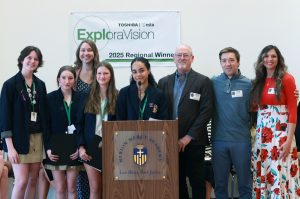
Nasal Spray Nano Particles (N.S.N.P.)
Created by 8th graders Malin Jurgensen, Ashlyn Turoff, Bianca Fontaine, and Hollyn Bauer from Avalon Middle School in Orlando, Florida. Supported by Coach Fadia Ahmed Hussien.
N.S.N.P. is nasal spray with carbon nanotubes that is meant to prevent the Naegleria Fowleri from entering the brain. Naegleria Fowleri is an amoeba that can enter through your nasal cavity when swimming in warm bodies of water. The bacteria travels to the brain and destroys the brain tissue. The idea behind this nasal spray technology is that the mixture of carbon nanotubes, infused with Amphotericin B, would trap the amoeba like a spider web to prevent it from traveling up the olfactory nerves to the brain. Amphotericin B, which is an antifungal medicine, has been proven to kill the brain eating amoeba. This would also cause an immune response which would kill the Naegleria Fowleri without it reaching the brain.
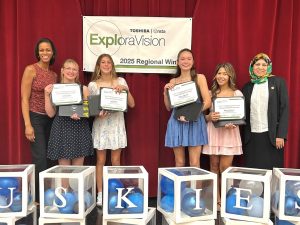
Drone Ranger (DR) for Fighting Wildfires
Created by 7th graders Aarnav Ghorai, Kyle Li, Srinithik Sabry from Twin Groves Middle School in Buffalo Grove, Illinois. Supported by Coach Nicole McRee.
The Drone Ranger (DR) represents a cutting-edge innovation in wildfire mitigation, combining advanced technologies to address the challenges posed by increasingly frequent and destructive wildfires. DR is a thermoelectricity and hydrogen powered drone made of stainless steel with tantalum hafnium carbide coating for unparalleled heat resistance. DR has a unique AI-trained camera network to monitor forest conditions and fires. DR uses a sophisticated Advanced Pressure Swing Absorption system to mitigate wildfires filtering out atmospheric nitrogen and recycling wildfire generated CO2.
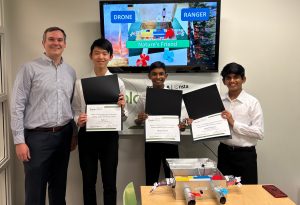
PEC Lenses
Created by 9th graders Angelica De La Torre and Janelly Garay from Skyline High School in Dallas, Texas. Supported by Coach Jasmine Jones.
The PEC Lenses is a medical device aimed to address daily needs to alert and respond to photosensitive epilepsy triggers. This technology will alert patients to potential seizure activity and aim to combat light intensity with an innovative combination of technologies.
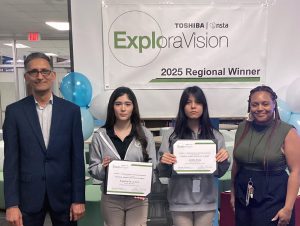
Stabil-Eyes: Smart contact lens for nystagmus
Created by 11th graders Tasmina Maysha and Anna Hsu from Bronx High School of Science in New York. Supported by Coach Joann Gensert.
The StabilEyes aims to revolutionize smart contact lenses to treat Nystagmus, an eye condition that causes involuntary eye movement. Current treatments don’t provide instantaneous or long-term relief. StabilEyes is a soft contact lens consisting of two main components: a piezoelectric actuator and a motor. The piezoelectric actuator generates electricity through the piezoelectric effect, converting mechanical- into electrical- energy. The actuator is then connected to a motor, which uses small vibrations to counteract the involuntary eye movement, stabilizing the user’s vision.
Nut Allergen Detection System (N.A.D.S.)
Created by 11th graders Martin Ordonez-Baquero, Sage Bogdan, Neel Gandhi, and Tyler Richardson from John Randolph Tucker High School in Henrico, Virginia. Supported by Coach Yvette Lee.
The Nut Allergen Detection System (N.A.D.S.) is a portable device designed for quick nut allergen detection. Using advanced biosensor technology, it identifies allergenic proteins in seconds via a swab mechanism and displays results on a mobile app. Inspired by microfluidic and biochemical detection systems, N.A.D.S. ensures high sensitivity and ease of use, making it a reliable tool for allergy safety. Compact and efficient, it’s ideal for on-the-go testing to protect individuals with nut allergies.
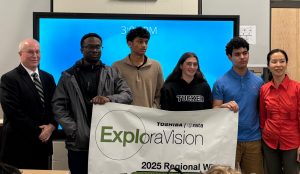
LeukoTrace
Created by 11th graders Parisa Majumdar, Shawn Ye, and Amala Mani from Enloe Magnet High School in Raleigh, North Carolina. Supported by Coach Rebecca Wright.
Cancer remains a global health challenge, with leukemia being particularly difficult to detect due to its lack of solid tumors. This team realized that four variations of leukemia stem from a single genetic anomaly: a chromosomal translocation of chromosomes 9 and 22. This insight led the team to develop a screening tool, LeukoTrace, for the BCR-ABL1 fusion protein that resulted from this translocation. LeukoTrace uses fluorescent antibody conjugation to detect antibodies associated with the fusion protein and includes a comprehensive screening kit and improves healthcare delivery.
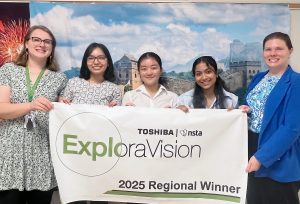
Seizor
Created by 11th graders Krishnapriya Nagasubramanian and Cynthia Li from Victoria Park Collegiate Institute in Ontario Canada. Supported by Coach Stacy Batras and Mentor Sarah Torrie.
Seizor is a device that aims to reduce and forecast seizures and provide automatic treatment for those suffering from seizures, so that they can experience a greater quality of life and reduced stress in their daily lives. It uses an AI feature and new technology such as vagus nerve stimulation.
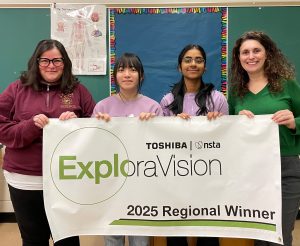
Ocular Photoreceptor Integration for Therapeutic Intervention and Compensation (OPTIC)
Created by Musa Rashid (10th grade), Aaron Denson (10th grade), Jaden Vu (10th grade) and Mohammad Rashid (12th grade) from the Harmony School of Innovation in Sugar Land, Texas. Supported by Coach Farha Ahmen and Mentor Rashid Rashid.
Ocular Photoreceptor Integration for Therapeutic Intervention and Compensation (OPTIC) proposes a bioengineered prosthetic scaffold to treat retinal degenerative diseases. The scaffold will be composed of three main components: Quantum Dot photoreceptors, flexible electrode arrays, and Hyaluronic Acid hydrogels. The device mimics native photoreceptor function and improves visual acuity to 20/80, increasing performance and minimizing inflammation in the process. The overall goal is to restore vision for 250 million people globally with cost-effective, scalable manufacturing.
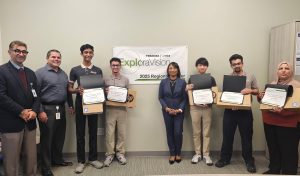
Nano Artertract Plaque Seeker (NAPS)
Created by Ziyang Deng (10th grade), Hannah Romero (11th grade), Lerou Li (11th grade), and Shelley Ajin (12th grade) from Downtown Magnets High School in Los Angeles, California. Supported by Coach Vy Le.
NAPS (Nano Artertract Plaque Seeker) is a non-invasive treatment for coronary artery disease designed to target and reduce arterial plaque buildup. NAPS utilizes iron oxide nanoparticles and magnetic guidance to ensure precise drug delivery. It is powered by rapamycin and necrostatin-1 as the main drugs to address inflammation and reduce plaque accumulation.
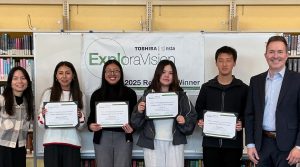
Please visit www.exploravision.org to sign up and receive notifications for ExploraVision competition updates.